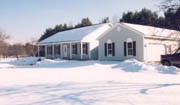
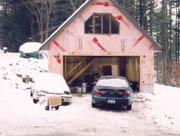
In a post on Walls & Ceilings' Web site in March 2001:
A United States lead study group was quoted as saying that "pre-conditioning interiors for just 24 hours prior to installing board can minimize cracking by some 20 percent. If board is installed without being pre-conditioned to the indoor environment, problems can appear within 24 hours after turning on heat or A.C."
The study also cautions that propane heaters should not be used for conditioning, as their exhaust dumps excessive amounts of moisture into the interior environment. Too-high or too-low humidity levels before, during and after will affect the job as well.
According to the USG Handbook, "Gypsum board should be ordered for delivery several days in advance of installation. Condition the drywall just as a carpenter would hardwood flooring before installing. In cold weather (outdoor temperature of less than 55 degrees F), controlled heat in the range of 55 to 70 degrees F must be provided. This heat must be maintained both day and night before, during, and after entire gypsum board joint finishing, and until permanent heating system is in operation or the building is occupied."
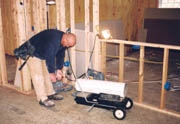
Cool intentions
Years ago, when I was working in my uncle's general contracting business, we would work out in nature's elements quite often. The cold temperatures in the winter, mud and rain in the spring, the hot summer afternoons, and the cool short days of fall. I even worked from time to time with my father and brother in their excavation business. So, I knew how much the weather affected their bottom line.My uncle sometimes would have trouble getting a drywall contractor when he needed one, so he would have me do the work. I really enjoyed the work and after a few simple lessons, I became quite good at hanging and taping. After a few years, I started to look at drywall work as a possible trade. I figured I wouldn't have to worry about rainy or hot days. I would be out of the hot sun and I could run some fans to keep cool. In the cold weather, I would be inside with the heat on. Plus, good hangers and tapers seemed to be in short supply so I figured I would have steady work year round.
After a couple of years of doing drywall work for my uncle, I decided to go into business for myself as a drywall contractor. Now, I was free of the sheltered professionally operated company that my uncle ran and I was out in the real world hustling to land jobs and at the mercy of the general contractor.
It wasn't long before I realized just how much of an effect the heat, rain, snow and mud affected my livelihood.
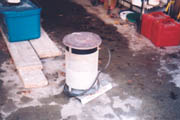
Hot air for a cool breeze
A job I completed this past November inspired me to write this article. Here in upstate N.Y., we had the rainiest summer and fall ever. I don't have to check record books. I just have to ask my brother, the excavator (if I dare). Let's just say after this past fall, he is looking at property in Arizona.Well, when I went to measure this new house that I was scheduled to drywall, the contractors were shingling the roof in the rain. When I went inside, I could see all the lumber was saturated with moisture (framing lumber commonly has a moisture content of 19 percent. After installation, the lumber develops about a 10 percent moisture content and consequently shrinks, particularly during the first heating season). Just knowing that the moisture content was very high in the lumber made me start to worry.
As we know, when there's rain, there is mud. Before the drywall delivery came, I had to practically force the GC to get some rubble for the delivery and have a bulldozer available in case the truck got stuck. Even with the rubble near the house, we could not get close enough to the upper window to load the drywall upstairs. Believe it or not, we even had to pull the truck out once empty.
With all the moisture in this house from the rain, I would need heat to dry it out and maintain a temperature between 55 to 70 degrees F. Every time I would try to talk to the GC about heat, he would cut me off by saying don't worry, he will take of everything. This was the first time I worked for him but I knew he had been in business for years, so I assumed that he knew what I needed.
On another rainy day, I showed up with my truck loaded with scaffolding, benches and all my hanging tools. I put my truck into four-wheel drive and backed as close to the house as I dare. The owner came out to greet us and proudly informed us that the heat is on. As I walked up a ramp, I could hear the roar and smell of the kerosene, and I knew at that moment that our great heat source was one of those kerosene blast torpedo-type heaters and my heart sank. This type of heater just blasts areas and cools down, blasts again and cools down. They smell really bad and I believe can be dangerous to one's health, to the home (fires) and to the drywall work.
When the GC came, I expressed my disappointment to deaf ears. But somehow, I did manage to get him to move the heater to the basement so that heat could radiate up but couldn't convince him to get a thermostat for the heater.
Why didn't I just leave? Because first, I had received a deposit, which covered more then just the material cost. Second, the scheduling-if I didn't start the job now I wouldn't be able to reschedule. Third, I was here with a full crew and all of our equipment and tools.
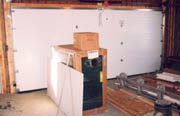
A little rain must fall
The cool rainy weather did break after the drywall was hung and we got some warmer days. I waited a day between coats of compound so things looked good when I finished the job. The GC wasn't very friendly so I saw no need to communicate very much with him. I knew I wouldn't be interested in working for him again so I just did my job, finished and was relieved to receive the balance due when I finished.While I was working on this job, I told my wife about all the problems with the job during supper one evening and she asked me if I told the GC that I wouldn't be able to guarantee the job will hold up once the heat was installed and turned on. I said no because I thought that mentioning this to him might jeopardize me getting the full payment.
This job was an unprofessional nightmare. My reputation was put on the line and the customer was not getting the quality job he deserved. All in all, the entire job was not given the professional attention it deserved for reasons I couldn't really understand. The typical GC does a much better job, but it is still rare that all the conditions are ideal for a high quality and long lasting drywalling job.
Looking back, this house was built during a wet, fall season. The damp drywall was hung over the damp framing lumber. The taping was done under extreme fluctuating temperatures. But even under these less-than-ideal conditions, I managed to leave the job with a professional quality looking hanging and taping job.
By now the heat must be on and the troubles are starting. When the phone rings, what do I say? Maybe the GC will listen now to my before, during and after speech.


Report Abusive Comment